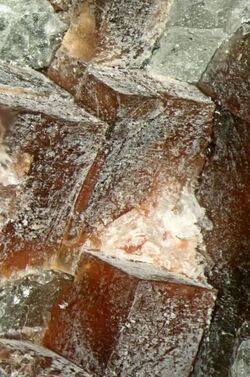Chemistry:Thermonatrite
From HandWiki
Short description: Naturally occurring mineral
| Thermonatrite | |
|---|---|
 Villiaumite and thermonatrite (powdery coating) | |
| General | |
| Category | Carbonate mineral |
| Formula (repeating unit) | Na2CO3·H2O |
| Strunz classification | 5.CB.05 |
| Crystal system | Orthorhombic |
| Crystal class | Pyramidal (mm2) H-M symbol: (mm2) |
| Space group | Pca21 |
| Unit cell | a = 10.72 Å, b = 5.24 Å c = 6.46 Å; Z = 4 |
| Identification | |
| Colour | Colourless to grey or yellow, white |
| Crystal habit | Acicular crystals rare; typically occurs as powdery crusts |
| Cleavage | Poor to indistinct on {100} |
| Fracture | Sectile |
| Mohs scale hardness | 1 – 1 1⁄2 |
| Vitreous|re|er}} | Vitreous |
| Diaphaneity | Transparent |
| Specific gravity | 2.255 (measured on synthetic crystal) |
| Optical properties | Biaxial (−) |
| Refractive index | nα = 1.420 nβ = 1.506 nγ = 1.524 |
| Birefringence | δ = 0.104 |
| 2V angle | 48° (measured) |
| Solubility | Soluble in water |
| Other characteristics | Readily dehydrates |
| References | [1][2][3] |
Thermonatrite is a naturally occurring evaporite mineral form of sodium carbonate, Na2CO3·H2O.[1][2]
It was first described in 1845.[3] Its name is from the Greek θερμός thermos, "heat", plus natron, because it may be a dehydration product of natron.[2]
Typical occurrence is in dry saline lake beds and as soil encrustations. It has been reported from volcanic fumaroles and in association with carbonatite-related veins. Common associated minerals include trona, natron and halite.[1]
See also
- Nahcolite
- Natron
- Niter
- Potassium nitrate
- Shortite
- Soda (disambiguation)
- Sodium sesquicarbonate
- Trona
References
- ↑ 1.0 1.1 1.2 Handbook of Mineralogy
- ↑ 2.0 2.1 2.2 Mindat data
- ↑ 3.0 3.1 Webmineral data
- ↑ Warr, L.N. (2021). "IMA–CNMNC approved mineral symbols". Mineralogical Magazine 85 (3): 291–320. doi:10.1180/mgm.2021.43. Bibcode: 2021MinM...85..291W.
 |

